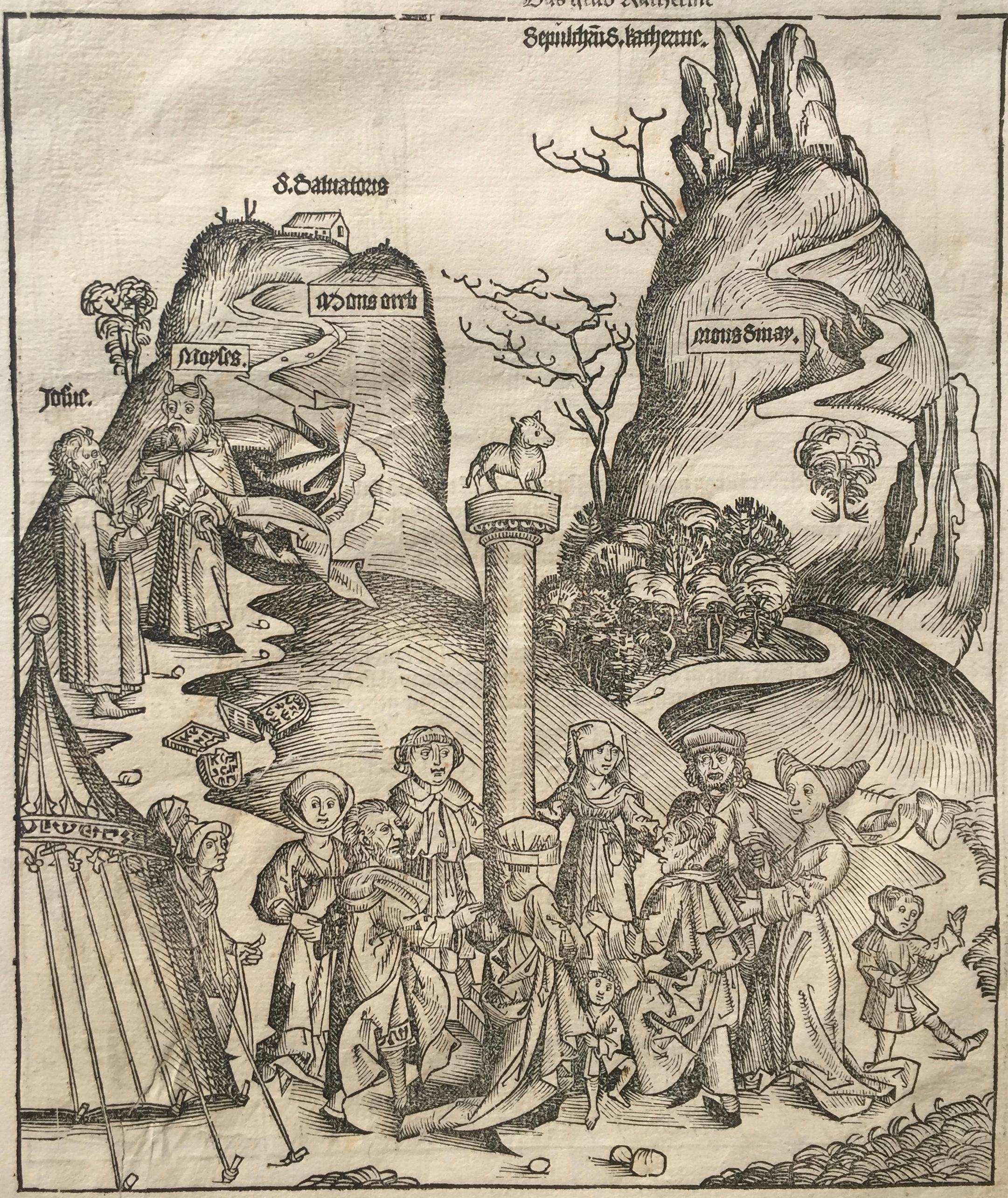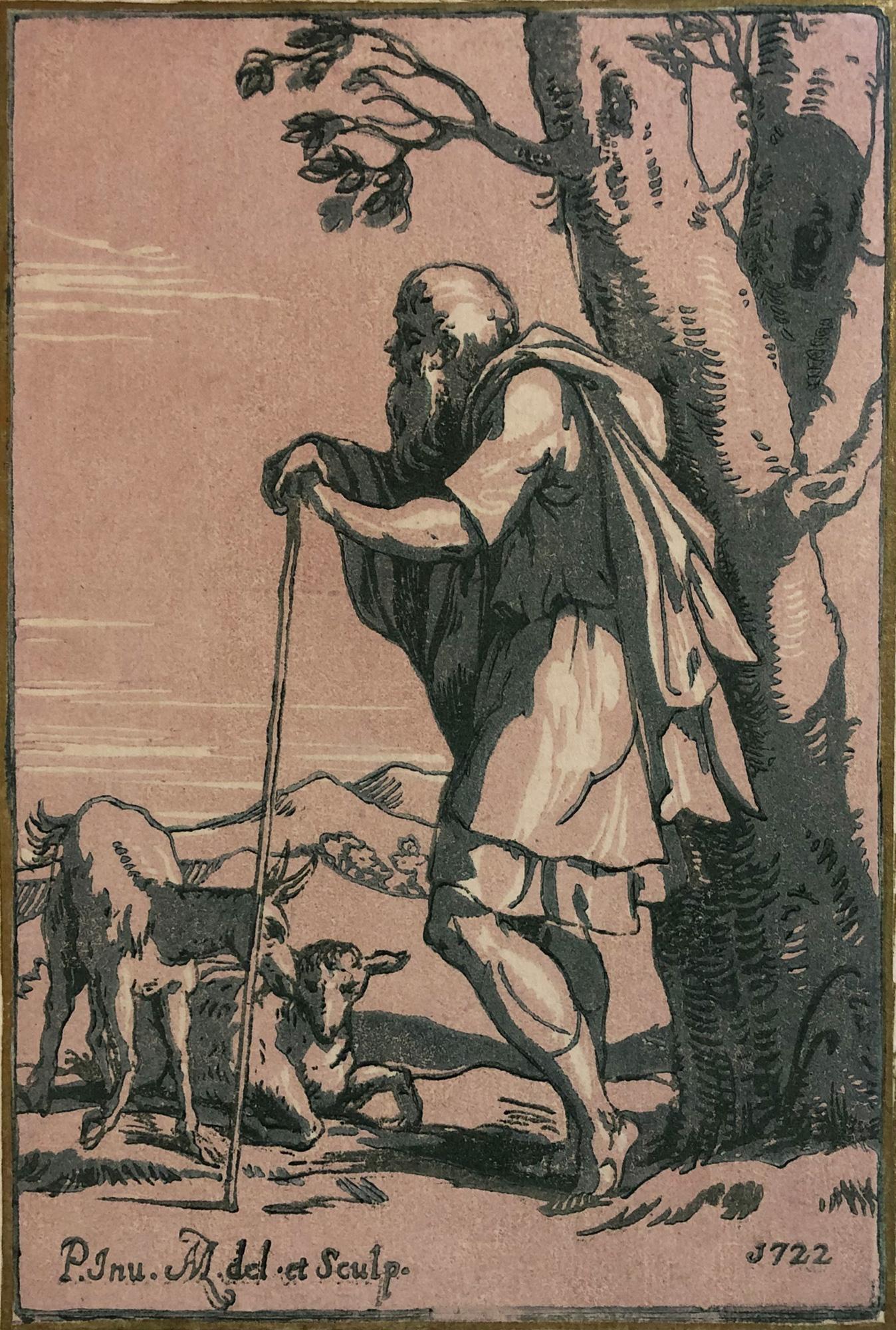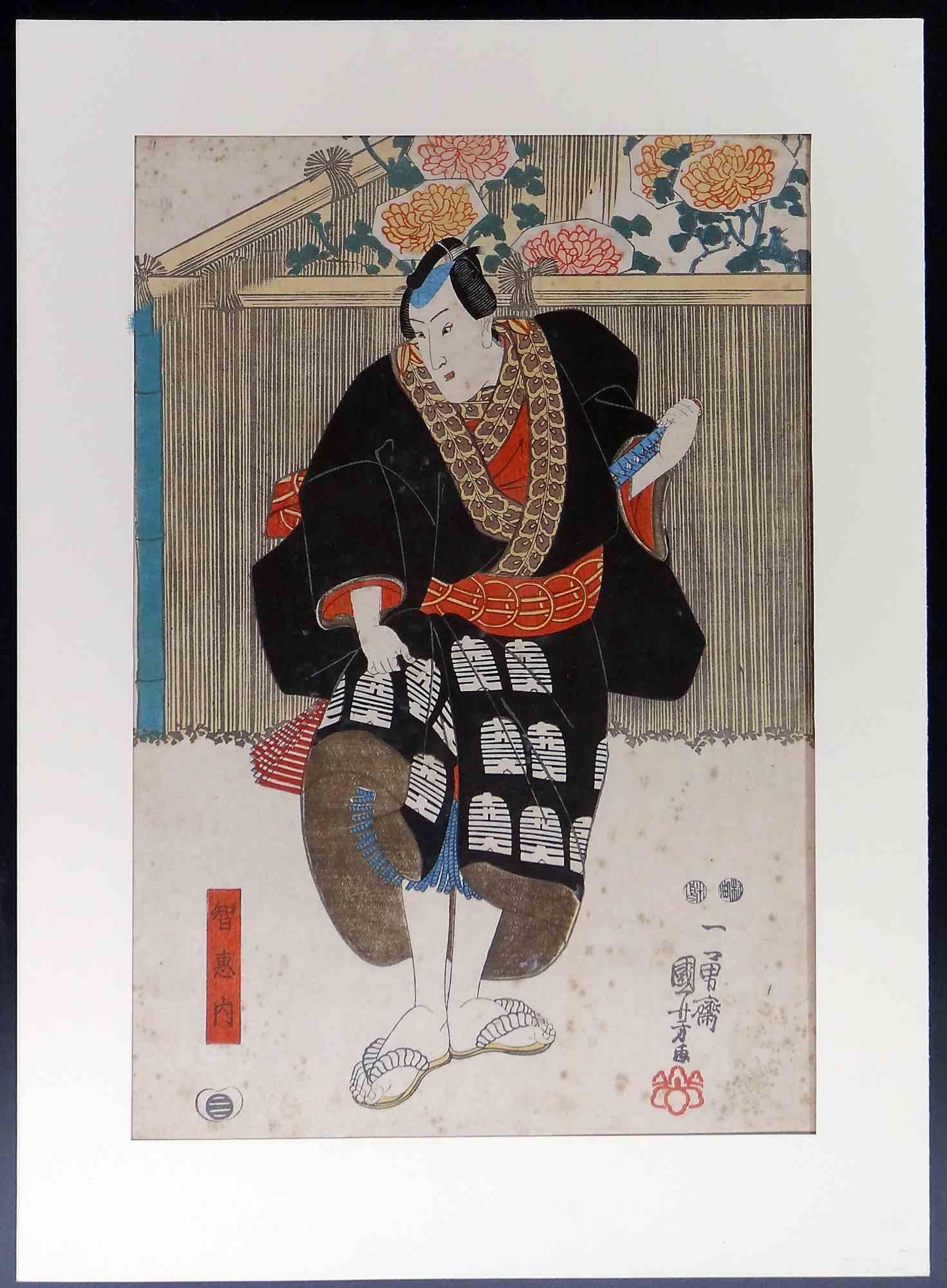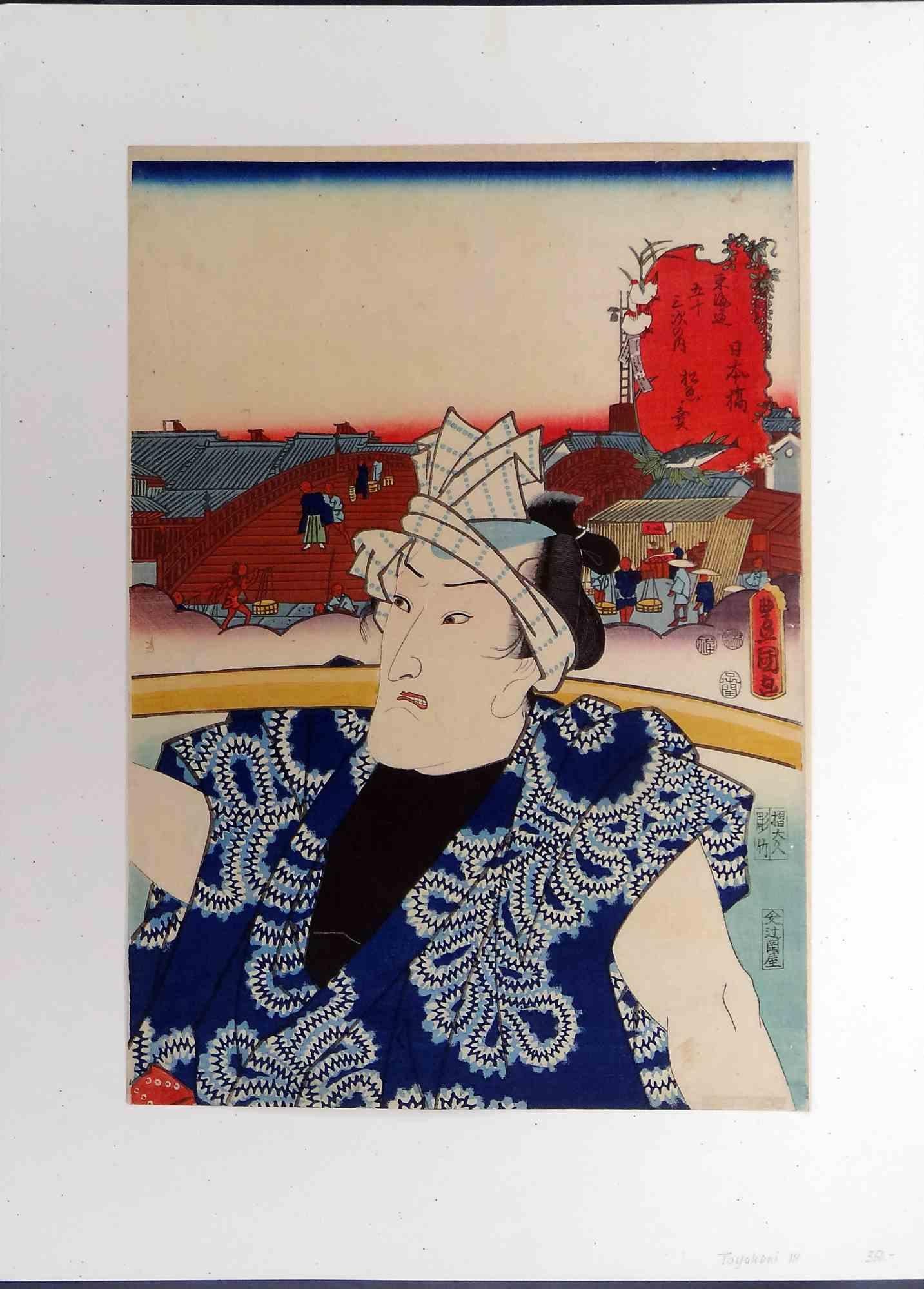Items Similar to Rônin in the Night, Armed with a Club - Woodcut by Utagawa Kunisada-19th Century
Want more images or videos?
Request additional images or videos from the seller
1 of 5
Utagawa Kunisada IIIRônin in the Night, Armed with a Club - Woodcut by Utagawa Kunisada-19th Century19th Century
19th Century
About the Item
This magnificent woodcut print signed Toyokuni III represents a Ronin in the night, armed with a club, and was realized by Utagawa Kunisada (1786-1865) in the mid 19th Century.
The subtle colors, the precision of the stylized textiles, the treatment of the faded decor, are a matter of great mastery.
In the traditional "oban" format, this beautiful piece is presented in a mat ivory bristol board.
In the outer size od 44.4x32.3 cm. Its state of preservation is excellent.
- Creator:Utagawa Kunisada III (1848 - 1920)
- Creation Year:19th Century
- Dimensions:Height: 14.14 in (35.9 cm)Width: 9.61 in (24.4 cm)Depth: 0.01 in (0.2 mm)
- Medium:
- Movement & Style:
- Period:
- Framing:Framing Options Available
- Condition:Insurance may be requested by customers as additional service, contact us for more information.
- Gallery Location:Roma, IT
- Reference Number:
About the Seller
4.9
Platinum Seller
These expertly vetted sellers are 1stDibs' most experienced sellers and are rated highest by our customers.
1stDibs seller since 2017
6,818 sales on 1stDibs
Typical response time: 3 hours
- ShippingRetrieving quote...Ships From: Grasse, France
- Return PolicyA return for this item may be initiated within 14 days of delivery.
More From This SellerView All
- Der Weisskunig - Woodcut Prints by Various artists - 1775Located in Roma, ITDer Weisskunig is an ancient set of Woodcuts realized in 1775, There are 14 plates from the Weisskunig series, the fictitious biography of Emperor Maximilian I...Category
18th Century Old Masters Figurative Prints
MaterialsWoodcut
- Theater Actor in Black Coat on Stage- Woodcut by Utagawa Kunisada - 19th CenturyBy Utagawa Kunisada IIILocated in Roma, ITThis figuration of a theater actor in a black coat on stage is the work of the Japanese artist Utagawa Kuniyoshi /1798-1861). The brilliance of the colors, the graphic precision as ...Category
19th Century Old Masters Figurative Prints
MaterialsWoodcut
- Man in Blue Coat Carrying Goods - Woodcut by Utagawa Kunisada - 19th CenturyBy Utagawa Kunisada IIILocated in Roma, ITThis portrait of a man in Blue Coat carrying goods in the work of the japanese artist Utagawa Kunisada (1786-1865), otherwise known as Toyokuni III. Whether through the use of color...Category
19th Century Old Masters Figurative Prints
MaterialsWoodcut
- Ancient Roman Fresco Herculaneum - Etching by Carlo Oratij - 18th CenturyLocated in Roma, ITAncient Roman Fresco from the series "Antiquities of Herculaneum", is an etching on paper realized by Carlo Oratij in the 18th Century. Signed on the plate. Good conditions. The e...Category
Late 18th Century Old Masters Figurative Prints
MaterialsEtching
- Ancient Roman Relief - Original Etching - 18th CenturyLocated in Roma, ITAncient Roman Relief, from the series "Antiquities of Herculaneum", is an original etching on paper realized by an anonymous Artista in the 18th century. ...Category
Late 18th Century Old Masters Figurative Prints
MaterialsEtching
- Ancient Roman Statue - Original Etching by Vincenzo Campana - 18th CenturyBy Vincenzo CampanaLocated in Roma, ITAncient Roman Statue, from the series "Antiquities of Herculaneum", is an original etching on paper realized by Vincenzo Campana in the 18th Century. Signed on the plate on the low...Category
Late 18th Century Old Masters Figurative Prints
MaterialsEtching
You May Also Like
- The Golden Calf - Nuremberg Chronicle, (528 Years Old)Located in Santa Monica, CANUREMBERG CHRONICLE, 1493 THE GOLDEN CALF (THE CALF OF GOD) 1493 Woodcut. from "Liber Chronicarum." Printed by Anton Koberger text by Hartmann Sc...Category
15th Century and Earlier Old Masters Figurative Prints
MaterialsWoodcut
- Hercule Gaulois, ou L’ÉloquenceBy Charles-Nicolas II CochinLocated in Middletown, NYA classical chiaroscuro woodcut after Raphael executed by Charles Nicolas Cochin Père (1688-1754) & Vincent Le Sueur (1668-1743) . Printed from two bloc...Category
Early 18th Century Old Masters Figurative Prints
MaterialsLaid Paper, Woodcut
- Elderly Shepherd Leaning on a Staff (after Parmigianino)Located in Middletown, NYA lovely chiaroscuro woodcut by Antonio Maria Zanetti the elder after a work by Parmigianino (Girolamo Francesco Maria Mazzola). Printed on cream laid paper, laid down to a cream lai...Category
Early 18th Century Old Masters Figurative Prints
MaterialsLaid Paper, Woodcut
- Saints Stephen, Sixtus, and LaurentiusBy Albrecht DürerLocated in Middletown, NYcirca 1504 Woodcut on cream laid paper, 8 1/2 x 5 7/8 inches (215 x 148 mm), thread margins. Significant expert repairs to lower right sheet edge, and center right sheet edge. Mino...Category
16th Century Old Masters Figurative Prints
MaterialsLaid Paper, Woodcut
- BATHOS / Tail PIeceBy William HogarthLocated in Santa Monica, CAWILLIAM HOGRATH (1767- 1764) THE BATHOS / Tail Piece 1764 (Paulson 1989: 216 I/I Paulson 1965/70: 216 I/I) Engraving Plate 12 7/8 x 13 3/8, sheet 17 ¾ x 18 ¾ Designed & Engrav’d by Wm Hogarth at left and Published according to Act of Parliam’t March 3, 1764 at right. Good condition on thick laid paper Small bit of tape on the left & right sheet edges small stan lower sheet edge all on recto. This Hogarth’s last print is fascinating as it is prophacy about death. Various institutions have interesting commentaries - to wit: Chicago Art Institute: Hogarth created The Bathos toward the end of his life. It is considered one of the bleakest artworks of the 18th century because it depicts the Apocalypse without an afterlife. The Angel of Death even collapses in exhaustion after having destroyed the world. In his hand is an execution decree and around him lies a mass of broken objects. Princeton: Hogarth’s last print, The Bathos,….. is filled with all manner of images denoting the end of life as we know it. Entry no. 216 in Ronald Paulson’s catalogue raisonne Hogarth’s Graphic Works, 3rd revised edition says “This print is the culmination of such pessimistic images . . . . [taking] his general composition, the configuration of objects, and some of the particular items, from Dürer’s engraving, Melancholia; but he also recalls Salvator Rosa’s Democritus in Meditation (which derives from Dürer’s print) with a scroll at the bottom of the etching: ‘Democritus the mocker of all things, confounded by the ending of All Things’ (Antal, p.168).” Newfields (Indianapolis Museum of Art): Hogarth intended this engraving to serve as the tailpiece to bound volumes of his collected engravings and, appropriately, it proved to be his last engraving. Father Time has died and his last will and testament has been witnessed by the three Fates. He is surrounded by a landscape of death, decay, and ruin. Hogarth aimed this print at dealers in “dark” Old Masters paintings who promoted the idea that ruins evoked sublime feelings in viewers—a sentiment, Hogarth wrote, that was reducing the world to ruin. British Caricature...Category
1760s Old Masters Figurative Prints
MaterialsWoodcut
- Father Stefan Fridolin, "Schatzbehalter" (Treasury of the True RichesLocated in Fairlawn, OHFather Stefan Fridolin, "Schatzbehalter" (Treasury of the True Riches of Salvation): The 30th Figure - Astrological Diagram with Scene of the Nativity Woodcut, 1491 Unsigned, as issued Published by Anton Koberger Diagram has Zodiac signs on outer ring, planets in the lower registers, and Nativity in the center. Condition: Very good for a 15h century woodcut, with the usual slight age stains Sheet size: 11 1/2 x 8 1/4 inches Wogelmut was the teacher of Albrecht Durer and employed young Durer in many project of the last decade of the 15th century. Michel Wolgemut Biography Wolgemut trained with his father Valentin Wolgemut (who died in 1469 or 1470) and is thought to have been an assistant to Hans Pleydenwurff in Nuremberg. He worked with Gabriel Malesskircher in Munich early in 1471, leaving the city after unsuccessfully suing Malesskircher's daughter for breach of contract, claiming she had broken off their engagement. He then returned to his late father's workshop in Nuremberg, which his mother had maintained since Valentin's death. In 1472 he married Pleydenwurff's widow and took over his workshop;[3] her son Wilhelm Pleydenwurff worked as an assistant, and from 1491 a partner, to Wolgemut. Some consider Wilhelm a finer artist than Wolgemut, however he died in January 1494, when he was probably still in his thirties. Wilhelm's oeuvre remains unclear, though works in various media have been attributed to him. Woodcuts Michael Wolgemut, Danse Macabre, 1493 Two large and copiously illustrated books have woodcuts supplied by Wolgemut and his stepson Wilhelm Pleydenwurff; both were printed and published by Germany's largest publisher, the Nuremberger Anton Koberger, who was also Dürer's godfather. The first is the Schatzbehalter der wahren Reichthumer des Heils (1491); the other is the Historia mundi, by Schedel (1493), usually known as the Nuremberg Chronicle...Category
15th Century and Earlier Old Masters Figurative Prints
MaterialsWoodcut
Recently Viewed
View AllMore Ways To Browse
In The Night
Armed A
A Matter Of Life And Death Poster
Albert Turner
Ancestor Silk Paintings
Arc Ciel
B 260
Back To The Future Vintage Poster
Beatles Psychedelic
Bird Of Prey Sculpture
Casino De Paris Poster
Charcoal Black Carved
Christian Poems
Dali Purgatory 10
Dames Et Des Modes
Di Sandro
Dior Iconic 1994
Dresden N





